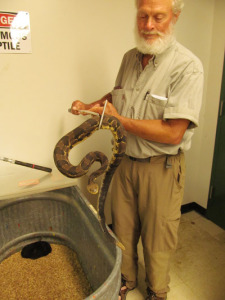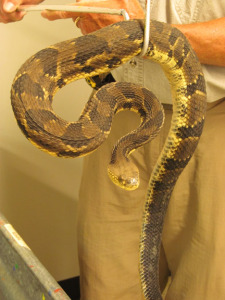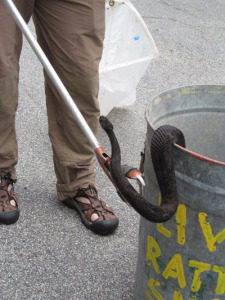By David Cederstrom, Chronicle Staff Writer
Five to 10 times each summer timber rattlesnakes are found around campsites in The Narrows area of Lake George.
This year, by the end of June, there were four such incidents, says research biologist/herpetologist Dr. Bill Brown.
But while this might sound alarming to some, since rattlesnakes are poisonous and their bite is potentially fatal if not treated, Dr. Brown said timber rattlers are not aggressive and will only bite a human in self-defense.
“In New York there have been no records of human deaths attributable to rattlesnakes in the wild during the last several decades,” says the state Department of Environmental Conservation.
Dr. Brown has been studying the local timber rattlesnake population for 35 years. The Fort Ann resident is a professor emeritus of Skidmore College.

He said that the snake, when confronted by a human, will try either to flee or to coil into a defensive position while producing a high-pitched buzz with the distinctive rattle at the end of its tail, indicating that it feels threatened.
If you come across a rattlesnake on Lake George, Dr. Brown said there’s a simple way to deal with it: Keep your distance and “call DEC and the Rangers will come and get it.”
“In most places in the United States, you won’t find a state agency that promotes and protects venomous snakes like this region here,” Dr. Brown noted.
Even here, until about 35 years ago, any rattlesnakes found would be killed. DEC said that rattlesnakes were wiped out at many New York locations, killed for the bounties once paid for dead rattlesnakes, or because they were considered a pest, or they were taken for the exotic pet trade.
Populations at Shelving Rock on the east shore of Lake George and at French Mountain were among those wiped out.
Bounties were outlawed in 1971 and in 1983 the timber rattler was designated a “Threatened” species by New York State. Killing, harassing, possessing or selling them is illegal. Rattlesnake populations exist at other locations around the state.
Dr. Brown has a permit from the state to study and transport the animals.
He says public awareness has changed. “Most of the time, the campers are quite sympathetic to the program….Most are loath to actually kill wildlife.”
“We have a greater than 90% save rate of rattlesnakes that got to the campsites over the last 25 years,” Dr. Brown said.
100-150 snakes removed in 25 years
He estimated that between 100 and 150 have been removed in that time. They’ve been found on about 15 islands over the years, as well as on the mainland, he said.
Most are males, which tend to travel more in search of females to mate with, but a quarter to a third are females, said Dr. Brown. He said they’re most likely to swim out to the islands or to the east side of the lake in July and August.
Dr. Brown collects the snakes captured by DEC Rangers, as well as ones he captures for his research, and weighs and measures them in lab space made available to him by Rensselaer Polytechnic Institute at the Darrin Fresh Water Institute in Bolton.
He checks to see if the snakes are ones he’s marked in the past, which many are, and marks them if not.
The snakes are then released in their home territory on the west side of the lake.
“We’re still doing a considerable amount of research” on the rattlesnakes, said Dr. Brown, who still occasionally teaches at Skidmore, and for the last eight years has taught courses at SUNY Albany.

Dr. Brown said he’s fortunate to be able to study a population where “we have the protected state lands, we have the cooperation of the Rangers, we have the actual protected status of the snake legally, and we have the relative inaccessibility and difficulty of the terrain.
“All of these factors reduce human interference. A study like mine couldn’t take place if there were much human interference at all.”
New finding: They live into their 40s
Dr. Brown said that “something totally unexpected” he’s discovered is that timber rattlesnakes can live into their 40s.
He said it had been thought that the snakes lived only up to 30 or so years, but two years ago he found a female he estimates was approximately 45 years old.
Dr. Brown said he marked the snake 30 years earlier and made what he feels is a “relatively conservative estimate” of her age as 15 at the time. He added he has also found males in their 40s.
The snakes’ reproductive behavior has been a focus of his study. Dr. Brown has found that on average, females produce offspring only 1.8 times per lifetime, “which is low,” he said.
Litters number four to 14 young, about a foot long at birth.
Some very rare individual females may reproduce as many as seven or eight times, but “reproduction is so difficult, so energy-expensive, and hard on the females physically” that 61% produce offspring only once in their entire lives, Dr. Brown said.
He said the survival rate for adult rattlers is very high — better than 90% of adults alive in a given year will still be alive the next year — and survival rates of newborns after one year is also “reasonably high,” about 65%.
It’s not the survival rate, it’s the low reproduction rate that’s the threat to the snakes, he said.
Population around LG stabliized
The population around Lake George appears to be stable, Dr. Brown said. “I do think they are coming back, but it’s slow, almost imperceptible.” He added that he has not analyzed his data for a scientific population estimate.
Dr. Brown expressed concern that last year was a poor year for reproduction numbers, and that he hasn’t seen a really good year for a long time. In the 35 years he’s been studying the snakes, he’s seen only three or four “spike” years of really good reproduction numbers.

The population does show some signs of revival compared to “50 years ago or 75 years ago or so when they were really being hard-hit by the bounty, especially after World War II,” Dr. Brown said.
He said there has been a slight increase in the number of rattlesnakes found on the islands, from two to four per year 30 years ago to the five to 10 of recent years, although he noted that in the past rattlesnake sightings might not have been reported as well.
Adult timber rattlers tend to be stocky, typically three feet to four-and-a-half feet long, DEC says. They eat mostly small mammals such as mice and chipmunks, but will also eat birds, amphibians and other snakes.
Timber rattlesnakes occur from New England to Texas to Wisconsin, although many populations in other states were also wiped out.
They hibernate; then might go miles
Timber rattlesnakes hibernate from October through April, gathering in overwintering dens below the frost line deep in the piles of rocks and boulders that collect at the bottom of cliffs. They typically travel one to three miles from the den for the summer, although some go farther.
Dr. Brown said that a rattlesnake killed by a car or otherwise is still valuable for scientific study.
But his handout sheet cautions: “BE CAREFUL: a freshly-killed rattlesnake CONTINUES TO BE DANGEROUS because of muscle reflex action. Handle the dead snake with tools only.”
It asks people to note the date and location and contact him. The carcass may be frozen in a plastic bag to preserve it.
To report a “nuisance” rattlesnake: DEC on Green Island, (518) 644-9684; DEC on Glen Island, (518) 644-9696; Dr. Brown, (518) 644-3541 or (518) 639-8819; Town of Bolton police/animal control officer, (518) 644-2444.
 Glens Falls Chronicle Serving the Glens Falls/Lake George region; Warren, Washington and northern Saratoga counties since 1980
Glens Falls Chronicle Serving the Glens Falls/Lake George region; Warren, Washington and northern Saratoga counties since 1980

